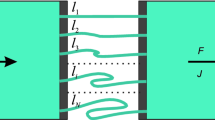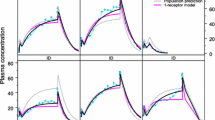Abstract
The model-independent estimation of physiological steady-state volume of distribution (\(V_{dss,p}\)), often referred to non-compartmental analysis (NCA), is historically based on the linear compartment model structure with central elimination. However the NCA-based steady-state volume of distribution (\(V_{dss,nca}\)) cannot be generalized to more complex models. In the current paper, two-compartment models with simultaneous first-order and Michaelis–Menten elimination are considered. In particular, two indistinguishable models \(\mathrm{M}_1\) and \(\mathrm{M}_2\), both having central Michaelis–Menten elimination, while first-order elimination exclusively either from central or peripheral compartment, are studied. The model-based expressions of the steady-state volumes of distribution \(V_{dss,\mathrm{M}_i}\,\,(i=1,2)\) and their relationships to NCA-based \(V_{dss,nca}\) are derived. The impact of non-linearity and peripheral elimination is explicitly delineated in the formulas. Being concerned with model identifiability and indistinguishability issues, an interval estimate of \(V_{dss,p}\) is suggested.



Similar content being viewed by others
References
Wang W, Wang EQ, Balthasar JP (2008) Monoclonal antibody pharmacokinetics and pharmacodynamics. Clin Pharmacol Ther 84(5):548–558
Wang YM, Sloey B, Wong T, Khandelwal P, Melara R, Sun YN (2011) Investigation of the pharmacokinetics of romiplostim in rodents with a focus on the clearance mechanism. Pharm Res 28(8):1931–1938
Kozawa S, Yukawa N, Liu J, Shimamoto A, Kakizaki E, Fujimiya T (2007) Effect of chronic ethanol administration on disposition of ethanol and its metabolites in rat. Alcohol 41(2):87–93
Craig M, Humphries AR, Nekka F, Bélair J, Li J, Mackey MC (2015) Neutrophil dynamics during concurrent chemotherapy and G-CSF administration: mathematical modelling guides dose optimisation to minimise neutropenia. J Theor Biol 385:77–89
Scholz M, Engel C, Apt D, Sankar SL, Goldstein E, Loeffler M (2009) Pharmacokinetic and pharmacodynamic modelling of the novel human G-CSF derivative Maxy-G34 and pegfilgrastim in the rat. Cell Prolif 42:823–837
Scholz M, Schirm S, Wetzler M, Engel C, Loeffler M (2012) Pharmacokinetic and -dynamic modelling of G-CSF derivatives in humans. Theor Biol Med Model 9:32
Bokemeyer C, Aapro MS, Courdi A, Foubert J, Link H, Osterborg A, Repetto L, Soubeyran P, European Organisation for Research and Treatment of Cancer (EORTC) Taskforce for the Elderly (2007) EORTC guidelines for the use of erythropoietic proteins in anaemic patients with cancer: 2006 update. Eur J Cancer 43:258–270
Perreault S, Burzynski J (2009) Romiplostim: a novel thrombopoiesis-stimulating agent. Am J Health Syst Pharm 66:817–824
Dirks NL, Meibohm B (2010) Population pharmacokinetics of therapeutic monoclonal antibodies. Clin Pharmacokinet 49(10):633–659
Wu X, Li J, Nekka F (2015) Closed form solutions and dominant elimination pathways of simultaneous first-order and Michaelis–Menten kinetics. J Pharmacokinet Pharmacodyn 42(2):151–161
Schmidt H, Radivojevic A (2014) Enhancing population pharmacokinetic modeling efficiency and quality using an integrated workflow. J Pharmacokinet Pharmacodyn 41(4):319–334
Woo S, Krzyzanski W, Jusko WJ (2006) Pharmacokinetic and pharmacodynamic modeling of recombinant human erythropoietin after intravenous and subcutaneous administration in rats. J Pharmacol Exp Ther 319(3):1297–1306
Shen HW, Jiang XL, Yu AM (2011) Nonlinear pharmacokinetics of 5-methoxy-N, N-dimethyltryptamine in mice. Drug Metab Dispos 39(7):1227–1234
Wang B, Ludden TM, Cheung EN, Schwab GG, Roskos LK (2001) Population pharmacokinetic–pharmacodynamic modeling of filgrastim (r-metHuG-CSF) in healthy volunteers. J Pharmacokinet Pharmacodyn 28(4):321–342
Gibaldi M, Perrier D (1982) Pharmacokinetics, 2nd edn. Marcel Dekker, New York, NY
Straughn AB (2006) Limitations of noncompartmental pharmacokinetic analysis of biotech drugs. In: Meibohm B (ed) Pharmacokinetics and pharmacodynamics of biotech drugs. Wiley, Weinheim, pp 181–188
Toutain PL, Bousquet-Melou A (2004) Volumes of distribution. J Vet Pharmacol Ther 27(6):441–453
Zou P, Zheng N, Yang Y, Yu LX, Sun D (2012) Prediction of volume of distribution at steady state in humans: comparison of different approaches. Expert Opin Drug Metab Toxicol 8(7):855–872
Berezhkovskiy LM (2004) Determination of volume of distribution at steady state with complete consideration of the kinetics of protein and tissue binding in linear pharmacokinetics. J Pharm Sci 93(2):364–374
Berezhkovskiy LM (2004) Volume of distribution at steady state for a linear pharmacokinetic system with peripheral elimination. J Pharm Sci 93(6):1628–1640
Yates JW, Arundel PA (2008) On the volume of distribution at steady state and its relationship with two-compartmental models. J Pharm Sci 97(1):111–122
Oppenheimer JH, Schwartz JL, Surks MI (1975) Determination of common parameters of iodothyronine metabolism and distribution in man by non-compartmental analysis. J Clin Edocrinol Metab 41:319–324
Benet LZ, Galeazzi RL (1979) Noncompartmental determination of the steady-state volume of distribution. J Pharm Sci 68(8):1071–1074
Wagner JG (1976) Linear pharmacokinetic equations allowing direct calculation of many needed pharmacokinetic parameters from the coefficients and exponents of polyexponential equations which have been fitted to the data. J Pharmacokinet Biopharm 4(5):443–467
Cheng HY, Jusko WJ (1988) Mean residence time concepts for pharmacokinetic systems with nonlinear drug elimination described by the Michaelis-Menten equation. Pharm Res 5(3):156–164
Godfrey KR, Chapman MJ, Vajda S (1994) Identifiability and indistinguishability of nonlinear pharmacokinetic models. J Pharmacokinet Biopharm 22(3):229–251
Shen HW, Jiang XL, Winter JC, Yu AM (2010) Psychedelic 5-methoxy-N, N-dimethyltryptamine: metabolism, pharmacokinetics, drug interactions, and pharmacological actions. Curr Drug Metab 11(8):659–666
Lakshmikantham V, Rama Mohana Rao M (1995) Theory of integro-differential equations. Gordon and Breach Science Publishers, Lausanne
Acknowledgments
The research in this work is supported by the NSERC-Industrial Chair in Pharmacometrics—Novartis, Pfizer and Inventiv Health Clinical (FN), NSERC (FN) as well as FRQNT (FN, JL). NSFC (No. 11501358) of P. R. China (XW and JL) and FRQNT (No. 193180) (XW) are also acknowledged for their support.
Author information
Authors and Affiliations
Corresponding author
Appendices
Appendix 1: Derivation Eq. 4 based on a two-compartment linear model with central elimination
For a two-compartment linear model with central elimination, the drug disposition of drug amount at central (\(A_1(t)\)) and peripheral compartments (\(A_2(t)\)) after a constant intravenous infusion rate \(R_0\) is
where \(k_{12}\) and \(k_{21}\) are distribution rate constants from the central to the peripheral compartment and vice versa, respectively; \(k_{el}\) is the linear elimination rate constant from the central compartment. Thus the concentration at the central compartment is \(C_p(t)=A_1(t)/V_1\), where \(V_1\) is the volume for the central compartment.
Following the physiological definition (Eq. 1), the steady-state drug amount in each compartment (\(A^{ss}_{1}\) and \(A^{ss}_{2}\)) satisfies
Solving the system (35), we obtain
Accordingly, the steady-state volume of distribution using compartment analysis is
On the other hand, the drug disposition of the two-compartment linear model after a single intravenous bolus administration is
where initial condition \(A_{1}(0)=Dose\) and \(A_{2}(0)=0\). Since system (37) is linear, the time course of drug plasma concentration can be written as
where the exponents (\(\lambda _1, \lambda _2\)) and coefficients (\(C_1, C_2\)) are determined as
and
After some straightforward calculations we obtain
and
Therefore, the steady-state volume of distribution using non-compartmental analysis is
Appendix 2: Derivation of indistinguishability of \(\mathrm{M}_1\) and \(\mathrm{M}_2\) (Eqs. 9)
We will claim that the relationships (Eqs. 9) in the case of intravenous bolus administration, the similar procedure can be used to obtain Eqs. 9 for the case of intravenous infusion. On the one hand, we assume that \(C_{1,\mathrm{M}_1}(t)=C_{1,\mathrm{M}_2}(t)\) for all positive time \(t\ge 0\). The equation \(C_{1,\mathrm{M}_1}(0^+) = C_{1,\mathrm{M}_2}(0^+)\) directly implies \(Dose/V_1=Dose/{\tilde{V}}_1\) which means
Since the functions of \(A_{1,\mathrm{M}_1}(t)\) and \(A_{1,\mathrm{M}_2}(t)\) are infinite differentiable at the right hand side of time 0, then we have \(A'_{1,\mathrm{M}_1}(0^+)=A'_{1,\mathrm{M}_2}(0^+)\) which is equivalent to
Rearrangement Eq. 39 leads to the following quadratic function with respect to Dose
where
Since Eq. 40 is valid for any Dose which implies that all coefficients a, b and c have to be zeroes, thence we have
Next we need to identify the relation of \(k_{21}\) and \(k_{el}\). Taking derivatives of \(A'_{1,\mathrm{M}_1}(t)\) and \(A'_{1,\mathrm{M}_2}(t)\) with respect to time t give rise to
and
Substituting \(t=0^+\) into Eq. 42 and Eq. 43 and using Eq. 41, the identity \(A''_{1,\mathrm{M}_1}(0^+) = A''_{1,\mathrm{M}_2}(0^+)\) yields
which is equivalent to
Taking derivatives of \(A''_{1,\mathrm{M}_1}(t)\) and \(A''_{1,\mathrm{M}_2}(t)\) again leads to
and
Therefore, \(A'''_{1,\mathrm{M}_1}(0^+) = A'''_{1,\mathrm{M}_2}(0^+)\) yields
which implies
On the other hand, we will claim that \(C_{1,\mathrm{M}_1}(t) = C_{1,\mathrm{M}_2}(t)\) for all \(t\ge 0\) if Eq. 9 are valid. In fact, by the method of variation of constants we have
and
Replacing \(A_{2,\mathrm{M}_1}(t)\) and \(A_{2,\mathrm{M}_2}(t)\) by Eq. 46 and Eq. 47 in the first equation of system \(\mathrm{M}_1\) (Eq. 5), respectively, these yield an initial value problem of a system of an integral-differential equation with respect to the time course of observed drug concentration, that is,
and
According to the Eq. 9, \(C_{1,\mathrm{M}_1}(t)\) and \(C_{1,\mathrm{M}_2}(t)\) have the same dynamical behavior. Therefore, the qualitative theory of differential equation implies \(C_{1,\mathrm{M}_1}(t)\equiv C_{1,\mathrm{M}_2}(t)\) under the conditions Eq. 9 [28].
Appendix 3: Indistinguishability of \(\mathrm{M}_{e}\) from \(\mathrm{M}_1\) and \(\mathrm{M}_2\)
The differential equations of model \(\mathrm{M}_e\) are
where f(t) is drug input. Similar to the derivation of Eq. 7, the dynamic behavior of plasma concentration with time of system \(\mathrm{M}_e\) (Eq. 48) can be expressed as
Comparing the equivalence of Eqs. 7, 8 and Eq. 49, and the qualitative theory of integro-differential equations [28], it follows that \(\mathrm{M}_e\) is indistinguishable from models \(\mathrm{M}_1\) and \(\mathrm{M}_2\) under the conditions Eqs. 20.
Rights and permissions
About this article
Cite this article
Wu, X., Nekka, F. & Li, J. Steady-state volume of distribution of two-compartment models with simultaneous linear and saturated elimination. J Pharmacokinet Pharmacodyn 43, 447–459 (2016). https://doi.org/10.1007/s10928-016-9483-z
Received:
Accepted:
Published:
Issue Date:
DOI: https://doi.org/10.1007/s10928-016-9483-z




